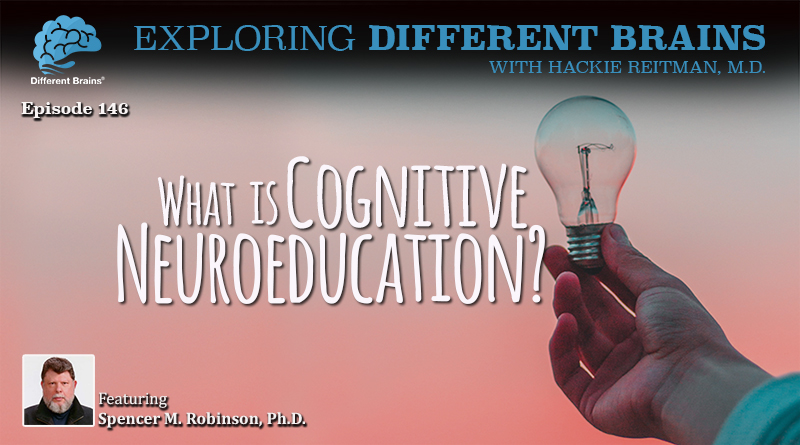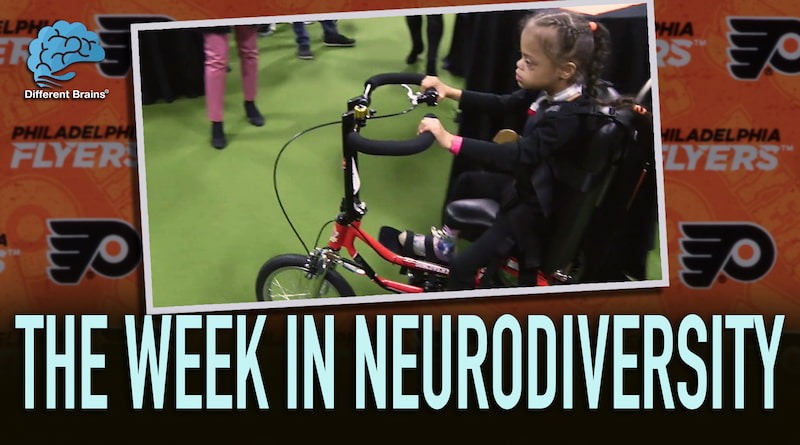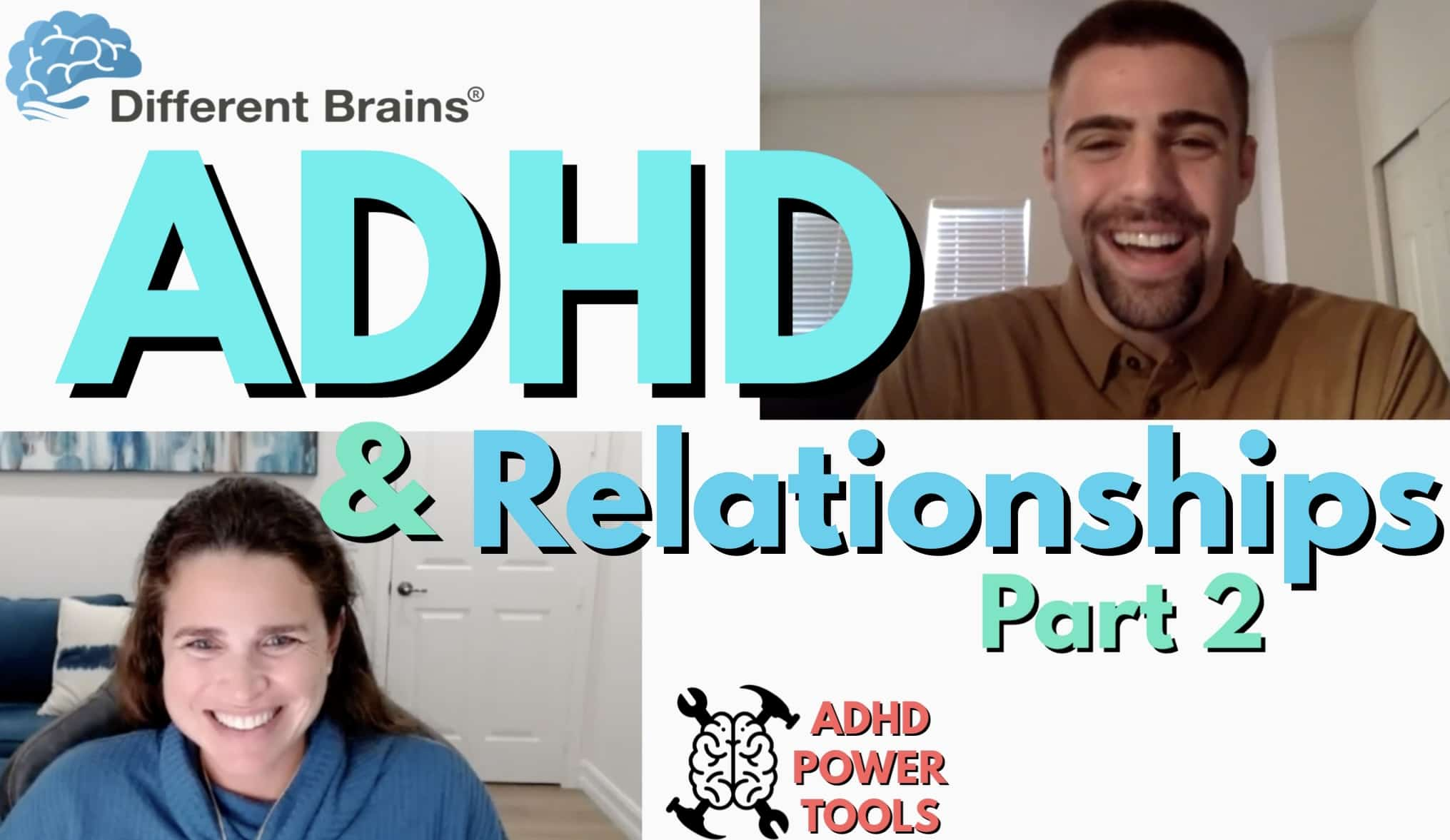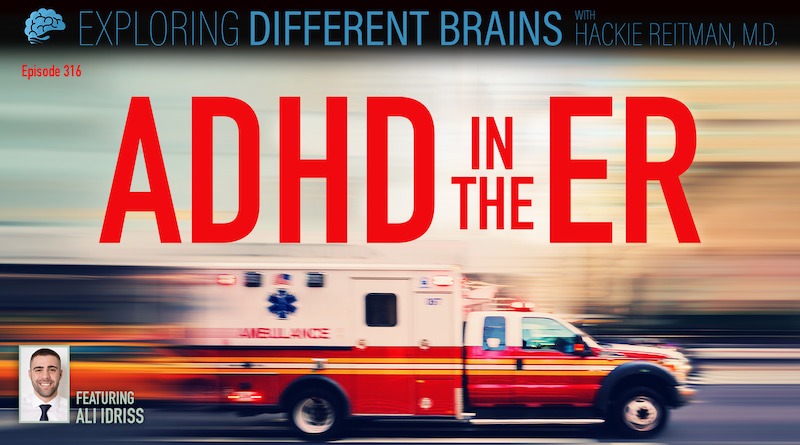
What is Cognitive Neuroeducation? with Spencer M. Robinson, PhD | EDB 146
In this episode, Dr. Hackie Reitman speaks with Spencer M. Robinson, Ph.D.
Dr. Robinson is the Executive Director and Chief of Research and Development for the Center for Applied Social Neuroscience, and the founder of the field of applied social neuroscience and the originator of Cognitive Neuroeducation. He discusses the differences between the brain and the mind, defines cognitive neuroeducation, and explains the importance in understanding the connection between the body and the brain. (24 minutes)
For more about Dr. Robinson’s work: https://www.Brain-Mind-Behavior.org/
.
To listen or download the podcast version of this episode, see the embedded player below.
Or look for us on your favorite podcast provider:
Apple Podcasts | Stitcher | SoundCloud
[expand title=”View Full Transcript”]
HACKIE REITMAN, M.D. (HR): Hello there. I’m Dr. Hackie Reitman. Welcome to another episode of Exploring Different Brains, and I’m so excited today because we’re going all the way around the world. We’re going all the way to Japan with Dr. Spencer Robinson, and it’s not every day I get to talk to somebody who invented a whole new science. Really that’s what we’re going to talk about today. We’re going to talk about how the center for applied neuroscience, what it’s all about, how this great man looks through the prism the same way DifferentBrains.org does, although we’re not as great as him, but every brain is different and no two are alike. They’re like snowflakes. Spencer, thanks for being with us.
SPENCER ROBINSON, PH.D. (SP): Thank you very much for having me. I don’t know if I can follow such a great introduction through.
HR: Well I want you to first of all, to straighten our audience out on the correct name of your organization, and with the correct name of the sciences, and introduce yourself properly, which I did not do.
SP: Alright, my organization is the Center for Applied Social Neuro-Science, um, (C.A.S.N.) um, and the field that I’m working in, I would call myself a neuro-psychologist, and um it’s very similar to a neuroscientist except that my basic focus, rather than the brain, is the mind, and that’s one big problem because a lot of people working in this field don’t recognize that there is a very, very great distinction between the brain and the mind, and I’m much more interested in the mind than I am in the brain, simply because we can only understand brain functions to a certain level, but translating them actually into the antecedents of human behavior becomes very, very difficult to do. So, I’m rather more focused on the mind and what the mind is, but of course I’d have to have a background and understanding of the brain before I can understand the mind, but again my focus is the mind because I’m really interested in what we are as humans, um, what the mind is and how we can affect the mind positively and how we can counteract behavioral problems through affecting the mind, so that is my emphasis and why I am a little bit different from the so-called neuroscientist.
HR: You are at the intersection of the mind and the brain, and it comes at a time when we finally have some technology available that lets you take a peak in, am I right about that? What are some of the basic science, neuroscience, clinical applications you’re applying at that intersection?
SP: Well, what you ask is a really, really complex question, um, there is a tremendous amount of controversy, uh, the advent of new technologies for imaging, brain imaging is fantastic, and offers a window of how the brain works that was never available before and those technologies are improving almost on a day by day basis. However, the problem is that a lot of neuroscientists make these huge jumps about looking at the imaging of the brain and various aspects of the imaging and then interpolating that in terms of actual behavior or thought processes of the mind that we cannot see, and we cannot really make a strong credible connection with. And that is my problem, so a lot of these imaging studies especially F.M.R.I. which is functional magnetic resonance imaging, try to make all kinds of claims to make them see, uh, different moods or they can test where somebody’s thinking this or that, different parts of the brains are replying and therefore that different parts of brains are responsible for different types of cognitive functions, and I’m sorry, but that just isn’t true. It really isn’t true. I don’t really want to get into a technical discussion right now, but we really, we can see certain things with the interpolation of those things, um, can only go so far. And we really still cannot jump that huge gap between again, brain and mind.
HR: What you just said is important so what I would like to if you can, give us some of the common examples where you think that a correlation has been made that perhaps has not really been proven, butt we made the jump, if you can think of any offhand.
SP: Just to give an example, a lot of F.M.R. studies claim that uh, if a certain area of the brain lights up in the F.M.R study, it means it’s active, therefore, that must be the brain where what you are seeing as behavior must be centered in that particular part of the brain that’s lighting up as you’re watching the behavior that you’re seeing, however, behavior is an incredibly complex phenomenon and even if you’re doing a math problem and the people who are, somebody who is scanning your brain, and seeing what’s lighting your brain while you’re doing the math problem, it doesn’t mean that you’re only thinking about the math problem, you’re thinking about everything that ever happened in your life up to that time. Why are you sitting in this F.M.R. machine doing this math problem? Who are you? What are you doing here? What are you getting out of it? Um, what did you have for breakfast this morning? What about your date that is coming at 8:30 tonight with this real hottie that you saw on the beach last week? All these things you’re going through, and by the way, my shoulder’s hurting in this bloody machine um, I want to twist and I want to turn. I can’t stand these things. All these things are going on, and those are electrical impulses shooting out of your neurons from one neuron to another, making these connections, and they’re all going like this, so, what does it mean that when one area is highlighted, what about all the other areas and all the other thoughts that you’re having at the same time and we do, so, making these interpolations of what we see as we think is behavior, and areas of the brain that are responsible for their behavior, I don’t think are creditable.
HR: Let’s jump into, explain to our audience. What, in your view, is cognitive neuroeducation that you are promoting.
SP: Okay, unfortunately, that’s also not an easy thing to explain, but let me try to see if I can simplify this.
HR: I see you can tell that you’re dealing with an orthopedic surgeon. You’ve got to dummy things down for me.
SP: Let me tell you what it’s not, maybe that’s the easiest way to do it, in as you know, there are many, many, many so called interventions that are being passed off as ways of remediating behavioral problems or cognitive dissonance, for instance, schizophrenic, schizophrenia patients may have this type of treatment or that type of treatment or that type of treatment. Some of it may be pharmacological, some of it may be a psychotherapy, but none of these have any real theoretical foundation to them. They just go out there, let’s see if we can kick the engine a little bit if it’ll start, that sort of thing. And most of it is based on what we call the medical model. Now, I have no problem with medicine, I mean I wouldn’t be alive today without the medical industry because I have a few problems myself, um, so, I don’t have a problem with medicine per se. I do have a problem with how some, sometimes the medicine is practiced today.
So, so not only do we base organic pathology, which is diseases, on the medical model, but unfortunately we are also basing behavioral difficulties on the medical model, which means that we are pathologizing behavior. We are saying that behavior is some kind of disease, mental illness. Now I don’t believe there is such thing as mental illness, I believe all behavior is a reaction to certain kind of situation, now, even in disease when we have a uh, an invasive organism that invades our body, our body reacts to it as a defense mechanism, to surround it, isolate it, and kill it. And in that process, we have infections, and the, uh, response to the infection, is to surround, and isolate it. Uh, and the process includes um, inflammation, fever, pain, all these things. But these are natural behavioral reactions of our immune system to fight this invasion, so, a lot of our behavioral reactions are also built-in natural reactions to confront a difficult situation, a difficult environment, pressures that are we are not able to deal with because they overwhelm us, um, so, rather than pathologizing, um, behaviors that are natural, that have been built into us as defense mechanisms, can help us keep our core, uh, personality intact without completely crushing us, um, I think it’s much better to understand what are the mechanisms of particular behavior. What are the core behavioral patterns that we have? How have we evolved as human beings that create unique behavioral patterns from us that differentiate us from other animals? And if we can understand those core behavioral, um, tendencies, then what are the neural physiological correlates of those behavioral tendencies, that we can understand that, then we can understand how to counteract these um, so-called maladaptive behaviors that we are using to try to overcome the pressures that society or environment is being placed on us, so that’s what C.N.E. is all about. So C.N.E., like, unlike any other, cognitive neuroeducation, which I call C.N.E., is unlike any other type of therapeutic. In fact, I won’t even call it a therapy, because I don’t believe there is an illness. All it is it is saying we are reacting to a situation, so the situation is what has to be attended to first, and then the behavioral pattern that we use to reaction to this situation can be reversed by a normal, natural stimulation that promotes positive behavior. That’s what I’m saying. That’s what C.N.E. is all about.
HR: You know, what you’re saying reminds me a bit of someone we interviewed here, Jim Sporleder. Who’s Jim Sporleder? He’s a principal out in Washington State, running the schools, and he was the law and order principal. So, what they did was, they identified the worst high school out there for behavior, and they brought in Jim Sporleder to straighten it out. And inside of two years with his discipline and law and order approach, it was ten times worse than it was before. It was horrible. And so, Jim stopped for a minute and he called in one of his students who was a particularly a bad actor, and said; “Are you having a bad day?” and the kid said “Yeah, as a matter of fact I am,” “What’s going on?” “Well, my father got out of jail last night, and came home and killed my mother.” Oh, that’ll put a crimp in your day. That’s an environmental change, so he began a trauma-informed approach, which he lectures on across, across the country, and uh, there’s been a documentary made about him, about Paper Tigers, and this sounds like one example of doing what you’re saying, which is to recognize the environment, analyze the situation, and then make a rational approach. Is that consistent with what you’re saying?
SP: Yes, yes it is, but the thing about, the reason that my center is called the Center for Applied Social Neuroscience is because I recognize the importance of understanding that we have a social brain. We are an inherently social species, and all learning takes place in a social context, and that may sound like an over, uh, pretty far out expression, but if you think about it, it’s true. Um, we learn in a social context, even if we’re reading a novel, we think about the social situation. What would I do in that place? What is this character doing? What are the social situations that are driving him to do what he’s doing? We become involved in that person’s life, and that person’s life is in a social situation, because we live in a society. So everything takes place in a social situation. Learning does too. All behavior is an outcome of learning. Everything is learning. The whole idea of socialization is learning how to behave in a society. So we, to allow us to learn more adaptable behaviors, we do it in a social environment. So then one of main areas, or the main emphasis, of C.N.E. is the group dynamic. That is a very important concept, the group dynamic. Um, and the idea of neuroplasticity and perception, all these things come into play, and understanding and retraining the brain to overcome this habitual reactive behavior into analyzing the situation, and to think about how the other person is going to react to us. We’re beating up on them when they didn’t do anything except have problems with their stomach or whatever that’s causing these sounds that are irritating somebody, so, we have to always put ourselves in the other person’s position, which is perspective-taking, which is another big part of C.N.E., so we train ourselves to do that. We train ourselves to be sensitive, not only to ourselves, but to others as well.
HR: Very well said. Very well said and very enlightening, and certainly strong social relationships are being identified as one of the most important things for your longevity and your overall health, whether you’re talking about your brain or your heart or cancer or anything.
SP: Absolutely, well, there was a correlation, or there’s an absolute connection between the brain and the heart, and everything. We have this idea that the brain and the mind and the heart, and all these are completely different things, but they’re not. One affects the other which affects the other. The human body is a system, and anything goes wrong, and that system, that system starts to break down in different places.
HR: Well then that leads to the gut-brain, the whole gut-brain interface, with the microbiome and flora in your gut, affecting how your brain gets wired with neuroplasticity too.
SP: Well then, that affect everything, certainly, I mean, for instance, kidney disease can cause dementia, I mean, so, the body is related. If the body is unhealthy, then other parts of the body are also going to become unhealthy, which can lead to, again, to behavioral disturbances.
HR: Spencer, what is the biggest roadblock to the work you do?
SP: Oh God, uh, the academic community, and the medical community.
HR: Elaborate.
SP: They don’t want anything that helps without drugs. Big pharma controls everything. Big pharma sponsors all the research and funds all the research, and they don’t want something that cures anything without taking a lot of drugs, and the medical industry kowtows to that, and they bully everybody else. I shouldn’t say that out loud and shouldn’t say that so directly, but you wanted to know the truth, honestly that is the truth. That to me is my biggest stumbling block.
HR: How do people find out more? Like what if someone wants to come and meet you or come and have a good time over there? How do people get in touch with you?
SP: Well, my email. I have a website, uh, should I read it out to you?
HR: Absolutely, read your website, your email, anything you want to share with our audience, and Joseph and Reuben will probably put up graphics below, but why don’t you go ahead and say them?
SP: Okay, (C.A.S.N.) Center for Applied Neuroscience, the website is http://www.brain-mind-behavior.org
HR: And they can Google the name of the center which is; say that again.
SP: C.A.S.N. They can just Google C.A.S.N. it’ll eventually come up, but it’s probably easier, and quicker to write in the URL, type URL.
HR: And would you like to share you e-mail?
SP: My email is casn@brain-mind-behavior.org
HR: Is there anything else that you’d like to cover with us today here at Different Brains?
SP: Well, I’m a researcher and a scientist. I’m a researcher. I’m not a clinician. I’m not a marketeer, but I think that C.N.E. is an extremely important approach and a new understanding of the brain, mind, and behavior connect to each other and how they work, um, and I think it’s extremely important to get the message out, because I think it can do a tremendous amount of good. Uh, I think it can treat, I hate the word treat, I think it can help people that have various, uh, behavioral problems that have been, uh, diagnosed as schizophrenia, or dementia that have been previously pretty much intractable with psychotherapy and with medication that I believe C.N.E. can do a tremendous job with because it has a scientific background, and it works.
HR: Spencer, you’re over there in Japan; you’re kind enough to spend your valuable time with us and to enlighten our Different Brains audience. What is one thought you’d like to leave our audience with?
SP: We, most of the problems that we have behavior can be overcome. Even with C.N.E., I feel that, uh, there’s very little that we cannot help with. The only time is when there is absolutely massive tissue damage, but beyond that, C.N.E. can provide remediation, to an extensive degree, and in most cases, can provide almost full recovery, maybe full recovery. It depends on the person and the situation. Remember, most of behavioral maladaption is situation caused, and if you put the person back in the same situation that caused it, obviously they’re going to get it again. So that’s another thing to think about. What is your problem? Where is the stress and tension coming from? How can you avoid it? That’s the main thought.
HR: Spence Robinson, thank you very, very much for being with us today here on Different Brains.
SP: You’re very welcome. Thank you so much for having me. I really do appreciate it.
[/expand]




